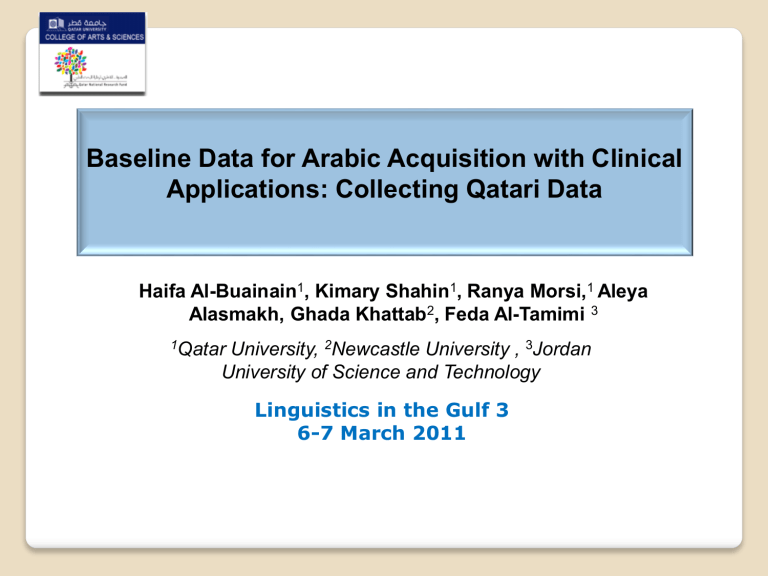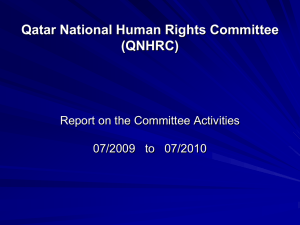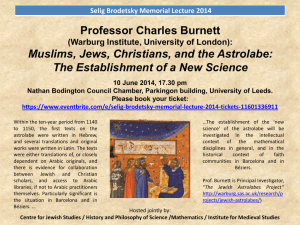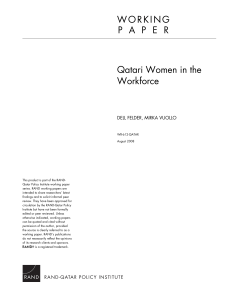Paper presented - Qatar University

Baseline Data for Arabic Acquisition with Clinical
Applications: Collecting Qatari Data
Haifa Al-Buainain
1
, Kimary Shahin
1
, Ranya Morsi,
1
Aleya
Alasmakh, Ghada Khattab
2
, Feda Al-Tamimi
3
1
Qatar University,
2
Newcastle University ,
3
Jordan
University of Science and Technology
Linguistics in the Gulf 3
6-7 March 2011
1. Introduction *
This presentation discusses the collection of Qatari child speech data. For a large project, we are obtaining audio recordings of 1/2-hour spontaneous Arabic speech produced by
196 Qatari monolingual children in natural settings (e.g. home and preschools). Fieldworkers produce digital files of the child speech recordings, and text file transcripts of the recordings. Our data are being analysed and coded in the CHILDES format
(MacWhinney 2010).
“Baseline Data for Arabic Acquisition with Clinical applications” is a three-year interdisciplinary project in Linguistics and Children’s Health. It is multi-institutional and international. It is a cross-sectional study of child speech which involves research on normal conversational interaction produced by native Arabic-speaking children between the ages of 1 year and 4 months to 3 years and 7 months. The overall goal is to collect extensive new material on five colloquial Arabic dialects: Qatari, Saudi,
Jordanian, Palestinian, and Lebanese.
____________________________________________________________________
* The authors gratefully acknowledge the funding of the Qatar National Research Fund (grant NPRP 08-738-5- 107). We also thank our research assistants: Aleya Alasmakh, Eman Tohemar, Rama Tarawneh, Duaa’ Salem, Wissam Chidiak,
Selma Abdel-Hafiz, Maryam Khattib, Ayda Abudaya, Basma Hammad, and Hanine Taouk.
Specifically, the project aims to achieve four online bilingual Arabic-English resources:
Arabic Child Language Database, Analysis of the Arabic Child Language Database,
Arabic Child Language Norms and Clinical Reference Materials for Arabic Speech-
Language Pathology. The project will fill these resources with extensive material on five Arabic dialects. It will provide heretofore nonexistent baseline data on first language acquisition of Arabic, critically essential for Speech-Language pathologists working with Arabic children, and for linguists conducting research into the nature of language and first language acquisition. This is the second year of the project and we are still in the data collection stage.
The aim of this presentation is to inform our language acquisition colleagues about the project, to facilitate cross-germination of ideas at this relatively early stage of our research. The presentation gives a small taste of the kind of data the Qatar team is encountering. We first summarize the progress made toward accomplishment of the aims of the project in Qatar, and problems and difficulties encountered and how they are being solved. We hope this will be helpful for fellow researchers who do child language research in the Arab Gulf region.
2. Qatari Data Gathering
2.1. Participants
The children who are recorded are selected solely because they are native speakers of the Qatari dialect and because they are between the ages of 1 year
4 months and 3 years 7 months. The sample size is a total of 196 children: 28 children in 7 groups, half boys and half girls in each group, as shown in the table below.
Age Group Number of Children
1 1:4 - 1:7
2 1:8– 1:11
3 2:0 – 2:3
4 2:4 -2:7
5 2:8 - 2:11
6 3:0 – 3:3
7 3:4 – 3:7
14 boys and 14 girls
14 boys and 14 girls
14 boys and 14 girls
14 boys and 14 girls
14 boys and 14 girls
14 boys and 14 girls
14 boys and 14 girls
2.2. Method
In this section we give a brief explanation of the procedures used and summarize what the participants are required to do. Our recording takes place in a quiet room in the children’s private homes or at their grandparents' house or their uncle's house or at preschools or daycare centers. We are audio recording conversational interaction for half an hour of usable child speech data, spontaneous speech facilitated by the mother or the caregiver using soft toys, picture books or photos which could be from their own albums, etc. This is mainly to use anything that children normally use rather than something new. Although this would provide data on mother-child interaction patterns we made sure that this not end up being a question-and-answer session between child and mother. So we encourage natural interaction to include all styles, including mother disciplining the child, playing with the child, interaction while they are eating and while the mother is teaching different things. Each child wears a small wireless lavalier microphone, which is clipped onto the child’s clothing. The microphone connects to an Edirol-09 digital audio recorder, which records to a SD card.
Each child participant is to have his or her hearing screened. This is because hearing and language development are related, and the project needs to know if the child participants have normal hearing. A child’s hearing screening lasts from 3-5 minutes.
Before any recording takes place Parental Consent Forms are signed by the children’s parents. Also, a signed Principal’s Consent Form is obtained from the principals of the preschools attended by the children. Each child is free to be recorded or not recorded and to have his or her hearing screened or not. There is no pressure on the child to continue in the study even after enrollment. Each child and/or his or her parent or guardian is free to withdraw from the study at any time with no disadvantageous effects to them in any way. This study involves no risks or physiological, psychological or social discomforts for the participants. For each child, the speech recording and hearing screening is stopped if the child shows reluctance to have the speech recording or hearing screening done. Participants in this study are free to contact the investigators at any time during the study, and after termination of the study. Our project has QU IRB and QNRF ethical clearance.
After recording, the children’s audio data is saved on computer. Transcripts of the recorded child speech are made. Linguistic analysis of the transcripts is being conducted to reveal the patterns of linguistic structures in the child data, to see what the data can tell us about how Arabic children acquire language, and about language acquisition in general.
Later on, the child speech data and the results of the study will be made available to the world on the internet, on the project’s website, as mandated by our research design and our open philosophy.
2.3. Problems
The project has experienced difficulties with hearing screenings, payment to the children/guardians, location of child subjects, securing of permission from Qatar authorities, clarification of ‘Qatari Arabic’ as one dialect or a dialect group, and bilingualism among Qatari children.
2.3.1. Hearing Screenings
Our research design includes a hearing screening for each child participant. However
Qataris haven’t accepted to go to the clinic to do the hearing screenings for their children. So the alternative was to do the hearing screening at homes or at preschools, with a portable audiometer. However, a comprehensive search in consultation with HMC Medical Research Centre, HMC Audiology Department, and audiologists at Doha Clinic Hospital and the Magrabi Doha Center’s Audiology Unit revealed that no portable audiometer is available for borrow or rent in Qatar. This has forced the Qatar team to pursue buying an audiometer and, in the meantime, rely on professionally acceptable parental report about hearing level and middle ear function.
2.3.2. Payment to the Children ’ s Parents/Legal Guardians
The project’s research design includes a nominal payment to each child’s parent or legal guardian to thank them for participating in the study. However, Qatari parents have not accepted a cash payment. So we have changed our procedure so that the payment is in the form of a Jarir Bookstore gift voucher.
2.3.3. Official Permission
Getting official permission from authorities like the Supreme Council- Learning
Institute and HMC was not an easy job at all.
2.3.4. Finding parents and families
Finding children to participate has been a large challenge. Many families have wanted to help but without recording their children! Participants have been identified through social networking (Milroy 1987). They are either friends ’ children or the children of friends of friends. We also contacted different nurseries, and we’ve asked university students in different classes if they have brothers, sisters, relatives, etc. who are within the age groups of our study and who might be able to participate. We posted ads in the
University Forum in Arabic and English, on Facebook and on Qatar Living. When participants are found, contact details are gathered and the Fieldwork Research
Assistant (FRA) arranges the meeting. We are personally appealing to all Qatari employees at Qatar University. [If you know of a potential participant, please let us know! Thank you!!]
2.3.5. Varieties of the Qatari dialect
We are recording Qatari children who speak the Qatari dialect. We have some differences as a result of geographical, religious and social status.
2.3.6. Concentrating on monolingual children
Most Qatari children (within the project age range) nowadays are bilingual because they go to
English nurseries and schools. But we concentrate only on those who go to Arabic nurseries and the children we record include those who might know some English – but Arabic is still dominant, because the study focuses on first language acquisition of Arabic. This restriction on our child subjects, has increased the challenges involved in finding the required sample size for our Qatari data. We aim for children who talk no more than 30% English in their speech recording.
3. Challenges I faced as FRA in Qatar
1. Low level of cooperatation: e.g., care-givers not always willing to sit with the children, especially for 30 minutes. (This meant the child didn’t become a participant in the study.)
2. Cultural customs: e.g., not all mothers/care-givers will allow their voice to be recorded; not all parents will allow their child's voice to be recorded (yakhaafu min al 3ain)
3. Shy children: e.g., some children aren't very talkative with the FRA (if the mother isn't participating in the conversational interaction)
4. Transportation: a personal vehicle or personal driver required for the FRA
5. Transcription: extensive training required; transcription is very time-consuming, even despite lab-quality headphones
6. Lack of cookbook for the project: this large project, with its multiple data collection sites in several countries, is the first of its kind in the world, and of course has involved changes to (evolution of) project procedures. These, especially changes to the transcription protocol, required constant mid-stride adaptability
.
3. Data Analysis
In our preliminary phonological analysis of Qatari children’s speech, some phonological processes were evident.
A phonological process means “…..a mental operation that applies in speech to substitute for a class of sounds or sound sequences presenting a common difficulty to the speech capacity of the individual, an alternative class identical but lacking the difficult property” (Stampe,
1979:1).
Phonological processes describe the systemic errors that children produce in order to simplify the phonological system of the adults
(Steol-Gammon and Dunn, 1985)
3.1 Phonological Processes in Qatari Children’s Speech
Three main types of phonological processes have been noted in our preliminary analysis of the speech of Qatari children.
These are substitution processes, syllable structure processes and assimilation.
These processes are present not only in the speech of
Arabic-speaking children, but also in the speech of children speaking other languages as English, German, Cantonese,
Maltese, Turkish,...( Zhu Hua and Dodd, 2006)
3.1.1 Substitution Processes
Substitution Processes: This type refers to processes where one sound is substituted for another sound (Steol-Gammon and Dunn, 1985).
The following types are examples of substitution processes:
/r/ Deviation: In this process, /r/ may be replaced by /l/, by a vowel, or by a glide.
Also, it might be deleted or assimilated (Ammar and Morsi, 2006).
Child (m, 3;1): [ʔæz r æg] ⃗ [ʔæz j æg] (blue)
Sibilant Deviation: This process may take several forms. For example, sibilants may be substituted by interdentals or dental/alveolar stops (Ammar and Morsi,
2006).
Child (m, 3;1): [ʔæ s æd] ⃗ [ʔæ ɵ æ t] (lion)
Devoicing: In this process, a voiced consonant becomes voiceless (
Ammar and Morsi, 2006)
.
Child (m, 3;1): [ʔæsæ d ] ⃗ [ʔæɵæ t ] (lion)
Glottal Replacement: The child substitutes the fricatives and plosives by glottal stop.” (Ammar, 1992).
Child (f, 2;2): [ ʕ enæb] ⃗ [ ʔ ænæm] (grapes)
(the other changes will be explained in (3.2.3)).
3.1.2 Syllable Structure Processes
Syllable Structure Processes: This type refers to processes where the syllabic structure of the word is modified (Steol-Gammon and Dunn, 1985).
Example:
Consonant Cluster Simplification:
This process has several forms such as reduction of the cluster and cluster assimilation
(Ammar and Morsi, 2006)
.
Child (m, 2;8): [k æ lb ] ⃗ [k æ pp ʰ ] (dog) (there is also devoicing process)
3.1.3 Assimilation
Assimilation: In this process, the child assimilates one sound to another. The assimilation may be complete or partial. It might also be progressive or regressive
(Steol-Gammon and Dunn, 1985).
Child (f, 2;2): [ʕ e næ b ] ⃗ [ʔ æ næ m ] (grapes)
5. Where to find the project
• http://lughataltefel.qu.edu.qa/
• a centralised work hub, public face, and portal for interaction
References
• Ammar, W. (1992). Articulation Disorders in Arabic. Unpublished PhD Thesis,
University of Alexandria, Egypt.
• Ammar, W. and Morsi, R. (2006). Phonological Development and Disorders:
Colloquial Egyptian Arabic. In Zhu Hua and B. Dodd (Eds), Phonological
Development and Disorders in Children: A Multilingual Perspective (pp. 204-232).
Multilingual Matters Ltd.
• MacWhinney, B. (2010). The CHILDES Project. Tools for Analyzing Talk –
Electronic Edition. Part 1: The CHAT Transcription Format. And Part 2: The CLAN
Programs.
Available online Carnegie Mellon University.
http://childes.psy.cmu.edu/manuals/clan.pdf.
• Milroy, Lesley, (1987) 2nd ed . Language and social networks,. Oxford: Blackwell.
• Stampe, D. (1979). A Dissertation on Natural Phonology. New York: Garland.
at
• Steol-Gammon, C. and Dunn, C. (1985). Normal and Disordered Phonology in
Children. Austin: Pro-ed.
• Zhu Hua, Dodd, B. (2006). Phonological Development and Disorders in Children:
A Multilingual Perspective. Multilingual Matters Ltd.










